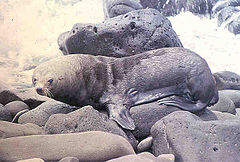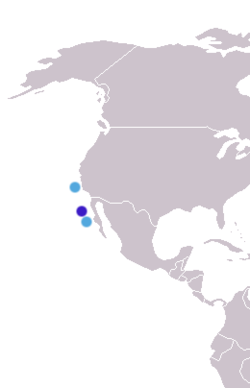Guadalupe fur seal
The Guadalupe fur seal (Arctocephalus townsendi) is one of six members of the fur seal genus Arctocephalus. Sealers reduced the population to just a few dozen by the late 19th century, but the species had recovered to 10,000 in number by the late 1990s. Many individuals can be found on Mexico's Guadalupe Island.
| Guadalupe fur seal | |
|---|---|

| |
| Conservation status | |
| Scientific classification | |
| Kingdom: | Animalia |
| Phylum: | Chordata |
| Class: | Mammalia |
| Order: | Carnivora |
| Suborder: | Pinnipedia |
| Family: | Otariidae |
| Subfamily: | Arctocephalinae |
| Genus: | 'Arctocephalus' |
| Species: | ''A. townsendi'' |
| Binomial name | |
| Arctocephalus townsendi Merriam, 1897
| |

| |
| Dark blue: breeding colonies; light blue: other colonies | |
Biology
editGuadalupe fur seals are sexually dimorphic in size, with the males being much larger than females, although few specimens have been measured. Individuals of both sexes are dark brown or dusky black, with the guard hairs on the back of the neck being yellowish or light tan. Pups are born with a black coat similar to that of adults. Observations suggest reproductive males are faithful to particular sites over a number of years. Tenure of territorial males lasts from 35–122 days. Births occur from mid-June through July, with most births taking place in June. The seals are one of the few with visible earflaps, confirming it is not a Phocidaen/true seal.
Distribution
editGuadalupe fur seals breed along the eastern coast of Guadalupe Island, approximately 200 km west of Baja California. In addition, individuals have been sighted in the southern California Channel Islands, including two males who established territories on San Nicolas Island.
Impacts on Guadalupe fur seals
editThe major cause of the Guadalupe fur seal's decline was commercial hunting in the late 18th and early 19th centuries. The species was exterminated in southern California waters by 1825. Commercial sealing continued in Mexican waters through 1894.
Conservation and recovery efforts
editThe species is listed as endangered by the U.S. National Marine Fisheries Service under the Endangered Species Act. The principal cause of the decline in Guadalupe fur seals was commercial sealing. The species is now protected from such activity throughout its range, and the magnitude of the threat to the species is considered to be low. The portion of the Guadalupe fur seal's range which is under U.S. jurisdiction is at the limit of the species range. No activities in areas under U.S. jurisdiction are known to be adversely affecting recovery of this species now. Therefore, management activities in the U.S. portion of its range are not likely to contribute substantially to recovery. However, Guadalupe fur seals are protected from federal actions that are likely to jeopardize the species through interagency coordination under Section 7 of the Endangered Species Act. No other specific actions necessary for the recovery of the species have been identified, and no direct recovery actions are being implemented.
References
edit- Belcher, Rebecca L.; and Thomas E. Lee, Jr. (2002). "Arctocephalus townsendi". Mammalian Species (700):1–5.
- Template:RefAudubonMarineMammals
